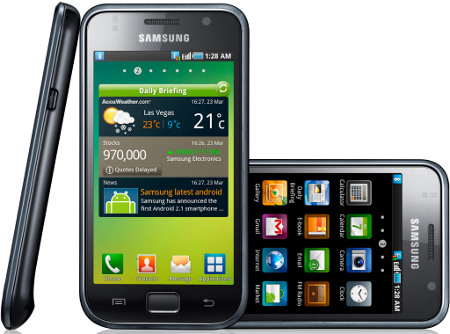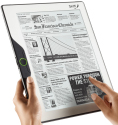Android phone sports four-inch Super AMOLED display
Mar 24, 2010 — by Eric Brown — from the LinuxDevices Archive — 2 viewsSamsung Electronics announced an Android smartphone with a 1GHz processor and a four-inch, WVGA Super AMOLED touchscreen. The Galaxy S GT-I9000 is said to ship with either 8GB or 16GB of flash, and provides 3G HSDPA, 802.11b/g/n, Bluetooth, A-GPS, a five-megapixel camera, and a front-facing VGA webcam, says Samsung.
Like the Samsung Wave, a smartphone running Samsung's home-grown, "Bada" operating system, the Android-based Galaxy S offers an unnamed 1GHz processor. Several industry reports have suggested it's a Samsung processor, which would make sense. Our guess for both phones is the Cortex-A8-based, 45nm-fabricated S5PC110.

Samsung Galaxy S
(Despite the display configuration of the model on the right, the phone does provide accelerometers, says Samsung; click to enlarge)
Like the Wave, as well as Samsung's Android 2.1-based, pico projector-enabled I8250 smartphone, the Galaxy S is equipped with Samsung's Super AMOLED display technology with WVGA (800 x 480) resolution. Yet while the Wave's display measures 3.3 inches and the i8250 provides 3.7 inches, the Galaxy S jumps up to an even four inches on the diagonal. (This doesn't quite match the HTC Evo 4G Android 2.1 phone announced yesterday, which runs on Sprint's 4G WiMAX network and boasts a 4.3-inch WVGA display.)
Still, there's more to a display than size and resolution. The Super AMOLED (active-matrix organic light emitting diode) technology expands upon Samsung's earlier AMOLED displays, which are said to offer richer colors, easier readability in sunlight, and better contrast and viewing angles. Super AMOLED is said to be brighter, clearer, and less reflective than AMOLED, while reducing power consumption.
Like the Samsung Wave, the Galaxy S also features Samsung's mDNIe (mobile Digital Natural Image engine), borrowed from Samsung's latest LCD TV and LED TV products. The mDNIe technolology offers improved viewing angles and "super fast response," claims the company.
As can be seen from the spec list below, the Galaxy S keeps up with other high-end smartphones, offering 3G HSDPA, 802.11b/g/n, Bluetooth, A-GPS, and numerous sensors, among other touted features. Its five-megapixel camera can't match the latest phones, such as the HTC Evo 4G, with their eight-megapixel models, but the Galaxy S also provides a front-facing VGA video telephony camera that Samsung says can handle 720p video recording at 30fps (frames per second).
Measuring 4.82 x 2.53 x 0.39 inches, the Galaxy S weighs 4.16 ounces, says Samsung. The company does not list battery or talk-time details, nor does it mention audio features aside from support of numerous formats. Video playback support is also extensive, and in addition to the usual MPEG4, H.263/264, and the like, it supports DivX HD/XviD and VC-1, says Samsung.
The Galaxy S lacks a keyboard, but the phone provides the latest Swype predictive touch technology to help speed virtual keyboard sessions. A "Home Cradle" feature, which appears to be a stand, and possibly a docking/charging station, "enables use as a digital photo frame, table clock, calendar, and music station," says Samsung.
Android 2.1, augmented reality, and a Social Hub
Running Android 2.1, the Galaxy S supports Android Market, and offers Google mobile services like Google Search, Gmail, and Google Maps, says Samsung. The Galaxy S is also said to provide a "Layar Reality Browser," touted for its augmented reality capabilities and advanced location based services. The phone's "Social Hub" messaging integration application, meanwhile, "provides always-on social networks connectivity," according to the company.
Other touted features include the ability to view e-books (see farther below), as well as record, edit, and play HD video. A "user-defined daily briefing" offers instant access to weather, news, stocks, and the scheduler, and a "Write and Go" app lets users type first, and decide on a messaging format later. Other interesting software additions include support for DLNA (Digital Living Network Alliance) network sharing.
Specifications listed for the Samsung Galaxy S include:
- Processor — 1GHz application processor
- Flash — 8GB or 16GB, expandable via external slot to 32GB
- Display — 4.0-inch WVGA (800 x 480) Super AMOLED with mDNIe
- Wireless:
- 2.5G (GSM/GPRS/EDGE) on 850/900/1800/1900MHz
- 3G (HSDPA 7.2Mbps, HSUPA 5.76Mbps) on 900/1900/2100MHz
- 802.11b/g/n WiFi
- Bluetooth 2.0
- A-GPS
- USB — USB 2.0
- Still camera — 5-megapixel autofocus camera with "add me" and stop motion, plus self, action, cartoon, and smile, and panorama shot modes
- Video camera — VGA video telephony camera; front-facing; 720p video recording @ 30fps
- Sensors — Accelerometer; digital compass; proximity; light
- Software:
- "Social Hub"integrated messaging
- "Daily Briefing" aggregator
- Layar Reality Browser with augmented reality and LBS
- DLNA (Digital Living Network Alliance) sharing
- Swype text input
- ThinkFree for Microsoft Office 2007 view and edit
- "Smart Alarm"
- SMS, MMS, email, video messaging, Exchange ActiveSync
- "Write and Go"
- Offline and "no SIM" modes
- Voice command
- RSS reader "Smart Security"
- Dimensions — 4.82 x 2.53 x 0.39 inches (122.4 x 64.2 x 9.9mm)
- Weight — 4.16 oz. (118 g)
- Operating system — Android 2.1
 Samsung's e-book partnerships and new e-readers
Samsung's e-book partnerships and new e-readers
At a press event at the International CTIA Wireless show in Las Vegas yesterday, Samsung announced partnerships with Paramount Pictures and Hearst-owned e-reader start-up Skiff to bring content such as e-books and movies to the Galaxy S, according to a story in our sister publication, eWEEK. Skiff's lineup of e-periodicals includes Hearst publications such as Esquire, along with outside properties such as The New York Times, says the story. At CES, Skiff announced a Linux-based e-reader called the Skiff Reader (pictured).
The eWEEK story also cites Samsung's upcoming E60 e-reader, although it doesn't mention whether the Skiff partnership will apply to it, as well. On Mar. 10, eWEEK reported that the five-inch Samsung E60 will access Barnes & Noble's online store and utilize the bookseller's e-book lending feature. The E60 is said to offer a five-inch screen and use either a PC connection or built-in WiFi, as opposed to a 3G connection.
The E60 appears to be related to the Samsung e-readers that were announced at CES in January. These include the six-inch E6 and a 10-inch E101 model, both of which are equipped with 802.11b/g, Bluetooth, and enough battery power to last two weeks. Like the E60, both e-readers offer a built-in electromagnetic resonance (EMR) stylus pen.
The E60 will sell for $300, while the E6 was announced with a $400 pricetag at CES, and the E101 was said to cost $700. The operating system was not listed for any of these devices, although Linux would be a likely choice.
The eWEEK story also notes that Samsung's global share of the mobile device market was 20.1 percent in 2009, up from 16.7 percent in 2008. In 2009, Samsung was said to have shipped more than 200 million devices.
Stated JK Shin, president and head of Samsung Electronics' Mobile Communications Business, "The Android-powered Galaxy S will set a new standard for smart phones."
Availability
The Galaxy S GT-I9000 will "soon" be available in Europe, North America, Latin America, Australia, and Asia, says Samsung, which did not mention any specific carriers. According to the eWEEK story, the phone will ship this summer. The Samsung announcement may be found here.
The Galaxy S is being exhibited this week at CTIA this week at booth 1023.
The eWEEK story on the Galaxy S may be found here, and its earlier story on the Samsung E60 e-reader may be found here.
This article was originally published on LinuxDevices.com and has been donated to the open source community by QuinStreet Inc. Please visit LinuxToday.com for up-to-date news and articles about Linux and open source.